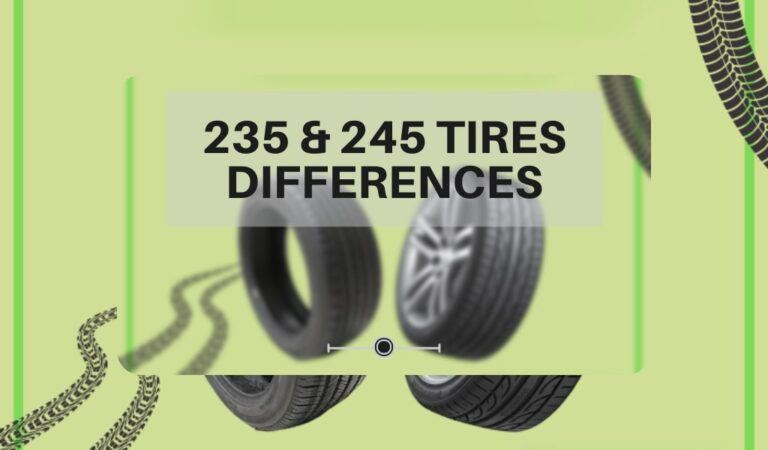There are plenty of options to choose from; in this post, we will narrow down the possibilities and dedicate the article to the difference between 235 and 245 tires.
Discover and learn the critical differences between tires 235 and 245, including their specifications and how to choose the best tire.
Ideally, the difference between these two tire types is size. The 235 tire measures 235 millimeters – from sidewall to sidewall, it is roughly 29 inches tall and 9.25 inches wide.
On the other hand, the 245 tire is relatively bigger, measuring 245 millimeters from sidewall to sidewalls. Additionally, it is 29-1/2 inches tall and 9.25 inches wide.
235 similar to 245 tire types are mainly designed for use for sub-heavy vehicles.
The tires are sturdy, durable, and highly reliable; thus, an excellent option for sub-heavy cars like Honda element and Audi A8.
Features & Specifications of 235 Tires
| Overall diameter | 29 inches |
| Section width | 235 millimeters |
| Rim diameter | 7.5 inches |
| Minimum tire width | 205 mm |
| Ideal tire width | 215or 225 mm |
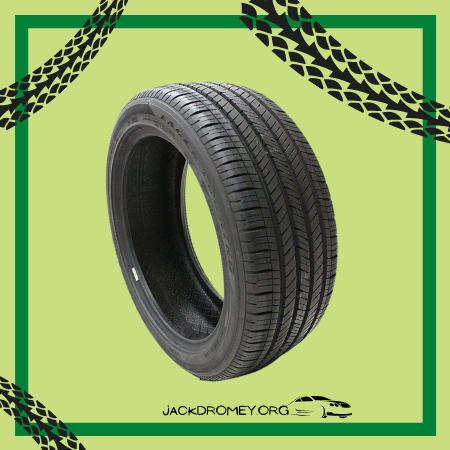
Features & Specifications of 245 tires
| Overall diameter | 29.5 inches |
| Section width | 245 millimeters |
| Rim diameter | 8.0 inches |
| Minimum tire width | 215 mm |
| Ideal tire width | 225or 235 mm |
| Rim range | 7.5 inches |
| Tread depth | 19 |
| Revs per mile | 555 |
| Load range | G |
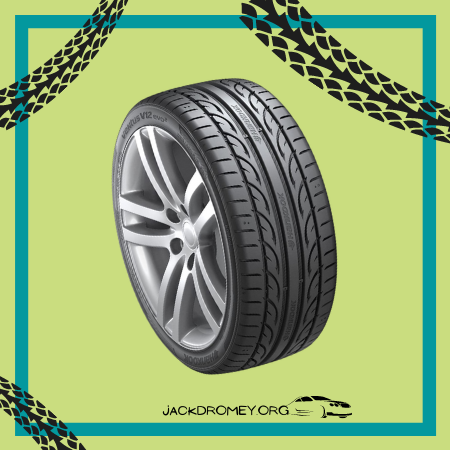
Common Difference Between 235 and 245 Tires
The difference between 245 and 235 tires looks negligible at eyesight but looked at keenly; the variations are extensive than you could imagine.
When choosing the right tire size for your vehicle, you may also want to consider the top all-season tires specifically designed for popular models like the Toyota Camry to ensure optimal performance year-round
Here is a look at the most notable differences between the two.
01. Rolling over resistance
The 245 tire is a thick, heavy, and more giant tire. As such, it has a high rolling over resistance.
As such, with additional rollover resistance and mass to push around in the 245 tires, you need extra fuel than when driving on 235 tires.
02. Car Loading capacity
Given the turgidity and strength, 245 tires carry a heavier load compared to the 235 sized tires. So, depending on your carrying capacity, you can always choose either of the tires.
03. Stability
Tire stability is a crucial element if you want to maintain road safety and enjoy comfortable rides.
That said, if you are considering tire stability, 235 is a stable tire compared to the size 245 tire. Thanks to its reduced width, which gives it stability in all driving conditions.
04. Handling
235 tires offer better handling when used on small cars, while the bigger width and deep thread blocks in the 245 tires give better handling when used on larger vehicles.
05. Performance
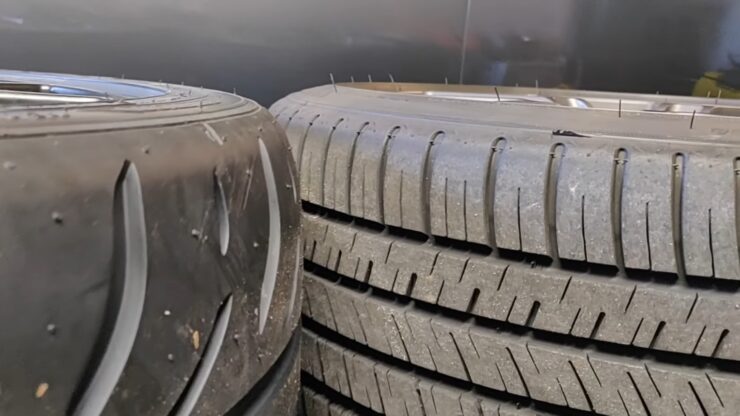
While 235 tires give excellent stability and excellent fuel economy, they lark behind when it comes to speed.
With the 245 tires, you get an additional 1.5 percent speed increase on your speedometer.
On general performance, a larger tire with circumferential and lateral grooves offers excellent performance and traction, especially in wet driving.
Enrich treads also enhance tire performance, but they are dependent on the manufacturer and tire design.
06. Weight
While weight is not a significant factor when determining tire choice or selection, it matters because the heavier the tire, the more energy you will need to push it around and thus the more fuel you need.
While tire weight plays little to no significance, the vehicle’s weight is essential in determining the type of tire you choose.
It is unrealistic, for instance, to choose a skinner tire for a heavy car, and the vehicle will mount too much pressure on the tire.
Equally, you don’t need a wider tire in a lighter car; this will most likely lead to wheelspins that may damage your car’s other internal systems.
07. Sidewall aspect ratio
The tire aspect ratio is the ratio of the sidewall to the tire’s width, and it is calculated as the total percentage tire width estimated from the edge of the rim to the tread surface.
In that respect, the 245 tire has a higher aspect ratio than the 235 tires, given its height.
08. Cost differences
Tire costs vary extensively depending on the manufacturer. But even with this, larger tires tend to cost more than their smaller counterparts.
So, practically 235 sized tire costs lesser and if you are considering upgrading the tires to size 254, you need a few more cents in your pockets.
09. Maneuverability
Large and wide tires offer more tractions on the roads and better vehicle handling.
How does this work? Wide tires, as opposed to thinner tires, cover a large surface area on the streets; this, in turn, increases its stability, making it easy to handle when especially maneuvering corners.
10. Traction
Pressure per square inch and the wider contact area are very critical in determining vehicle traction.
A wide-sized tire like 245 has a larger contact area, while 235 gives you more pressure per square inch. Ideally, you can’t have these essential elements in one tire.
So, you should balance them depending on the type of surface on which you drive your car.
Do you want to change or replace your tires? I am sure you don’t want to spend your money on something that doesn’t address your wants.
So, consider the differences in making any purchase.
While you’re exploring the differences between 235 and 245 tires, you might also be interested in learning about the comparison between 235 and 255 tires to make an informed decision about the best tire size for your vehicle.
Pros & Cons of 235 & 245 tires
235 pros
- Good fuel consumption
- Very economical
- A great tire for everyday car use
235 Cons
- Lesser handling flexibility
- Low rolling over resistance
245 pros
- Better handling
- Improved car aesthetics
- Smoother and comfortable rides
- Improved maneuverability
- Ideal for heavier cars
245 cons
- It is not economical compared to 235 tires
Frequently Asked Questions about the Difference Between 235 and 245 Tires
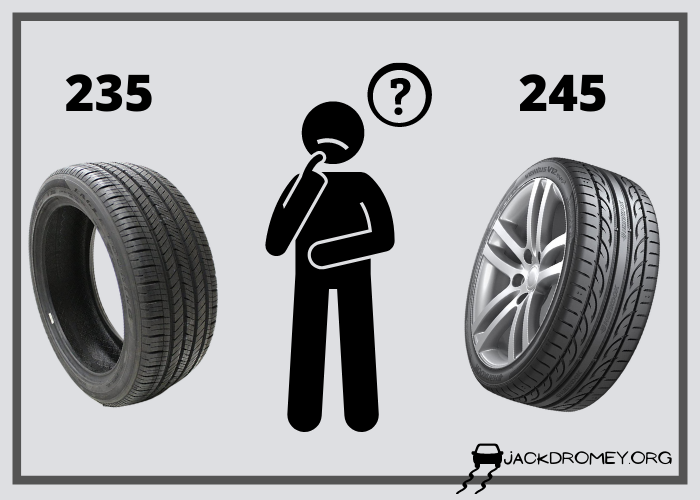
Can I replace 235 tires with 245?
The difference between tire 235 and 245 is negligible for even skilled drivers to notice. So, substituting either tire is possible what you probably need to worry about is the size of the rim and tire sidewalls.
But is it safe? This all relies upon what you need. Usually, 245 tires increase REV. Per mile for over 5% when compared to 235 tires, this possibly led you into overspeeding pegged on the differences in your speedometer reading and the actual car speed.
Are the 235 tires the same as 245?
No, the tires look similar in all aspects, but they are distinctively different. 235, for instance, is a small tire compared to 245 tires, which boasts additional height, weight, and width.
Honestly, if you are not an experienced driver or have a keen eye for details, you wouldn’t notice any difference between the two tire sizes.
We suggest looking for the help of a technician or a specialist.
How would I discover what tire size I want?
It is straightforward, but first, you need to identify your needs before delving into tire selection.
For example, you need a higher profile tire with a smaller width for winter driving, while the opposite is true for summer driving.
To find the right tire Size, find out which fits your rim. If you don’t know the dimensions seek help from an expert around.
Other size determiner includes the tire aspect ratio, rim diameter, speed rating. The 235 and 245 sizes are ideal for everyday car users and are very common in medium carloads.
Can I replace wider tires on my stock rims?
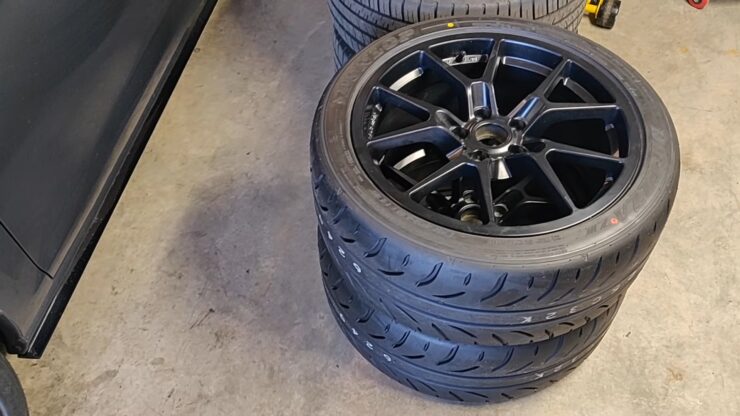
Yes, wider tires are an easy way of improving not only vehicle aesthetics but also its performance.
Switching to a higher and broader tire, for instance, improves lateral stability, improves tractions, and maintains the grip when especially making turns.
The tradeoff is: as the tire size increases, so do the weight, which negatively impacts the fuel consumption and makes the steering heavier.
How big can I go?
Replacing 235 for 245 tires poses no challenges when every factor and consideration is adhered to, but how high and wider can one go?
It would help if you had a tire that matched your rim size and one that wouldn’t affect the functioning of the tire.
For instance, you don’t want something that will rub against the fender when it turns, so, for everything to function as intended, make sure that both the stock diameter and width match those of the tire you plan to replace.
The general rule of the thumb is safe to replace bigger a tire of up to 20 millimeters more expansive than the stock original.
What is the difference between summer tires and winter tires?
Summer tires are designed to perform best in warm weather conditions.
They have a harder rubber compound and less aggressive tread pattern, which allows for better handling and increased fuel efficiency.
On the other hand, winter tires are designed to perform in colder weather conditions and offer better grip on snow and ice.
They have a softer rubber compound and more aggressive tread pattern to provide better traction in slippery conditions.
Can I mix and match tire brands?
While it is possible to mix and match tire brands, it is generally not recommended.
Different tire brands have different rubber compounds, tread patterns, and sizes, which can affect your vehicle’s handling and performance.
It is best to stick to the same brand and model of tires on all four wheels for optimal performance.
How often should I replace my tires?
Tires should be replaced when the tread depth reaches 2/32 of an inch, which is the legal minimum tread depth in most countries.
However, it is recommended to replace tires when the tread depth reaches 4/32 of an inch to ensure optimal performance and safety.
Additionally, tires should be replaced every six years, even if they have not reached the minimum tread depth, as the rubber can degrade over time.
What is the difference between tire speed rating and load rating?
Tire speed rating is the maximum speed that a tire is designed to handle safely. It is represented by a letter, with higher letters indicating higher speed ratings.
Tire load rating, on the other hand, is the maximum weight that a tire can safely carry. It is represented by a number, with higher numbers indicating higher load ratings.
It is important to choose tires with the correct speed and load rating for your vehicle to ensure optimal performance and safety.
Verdict
Unlike other parts of the vehicle, like the engine, they tend not to draw much attention.
You can’t roll down the roads if you don’t have tires; your tire type determines the far you can, the surface you can drive over, speed, slide, among other driving determinants.
Remember, when it comes to tires, the market is full of options, but it is essential to choose from the lot the best set that is compatible with your vehicle.
This way, you will be assured of a comfortable driving experience, road safety, and above all, efficiency and excellent performance.
Overall, 235 and 245 tires work well when matched with the right vehicle and driving condition.
So, while choosing your tires, always try as much as possible to establish a link between what your car needs, issues like fuel consumption, comfortable driving, and most importantly, the place where you drive have a significant impact on the tire you choose.
Related Posts:
- Difference Between 225 and 235 Tires - Easily Find…
- Difference Between 245 and 255 Tires 2024 – Easily…
- Difference Between 265 and 275 Tires in 2024 - Let's…
- Difference Between 235 and 255 Tires in 2024 -…
- Difference Between 275 and 295 Tires - Easy Tire…
- Difference Between 285 and 305 Tires - Best One to Choose

